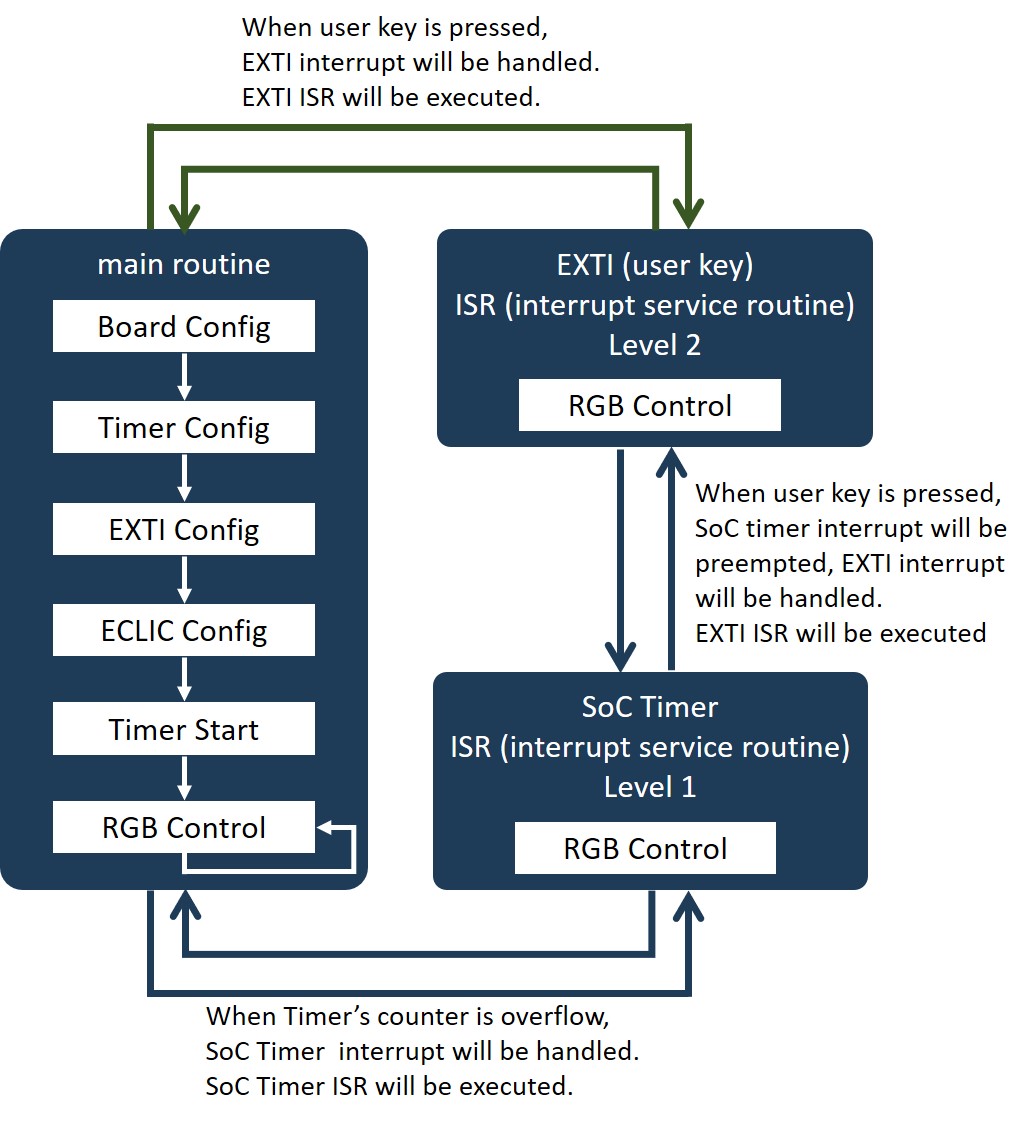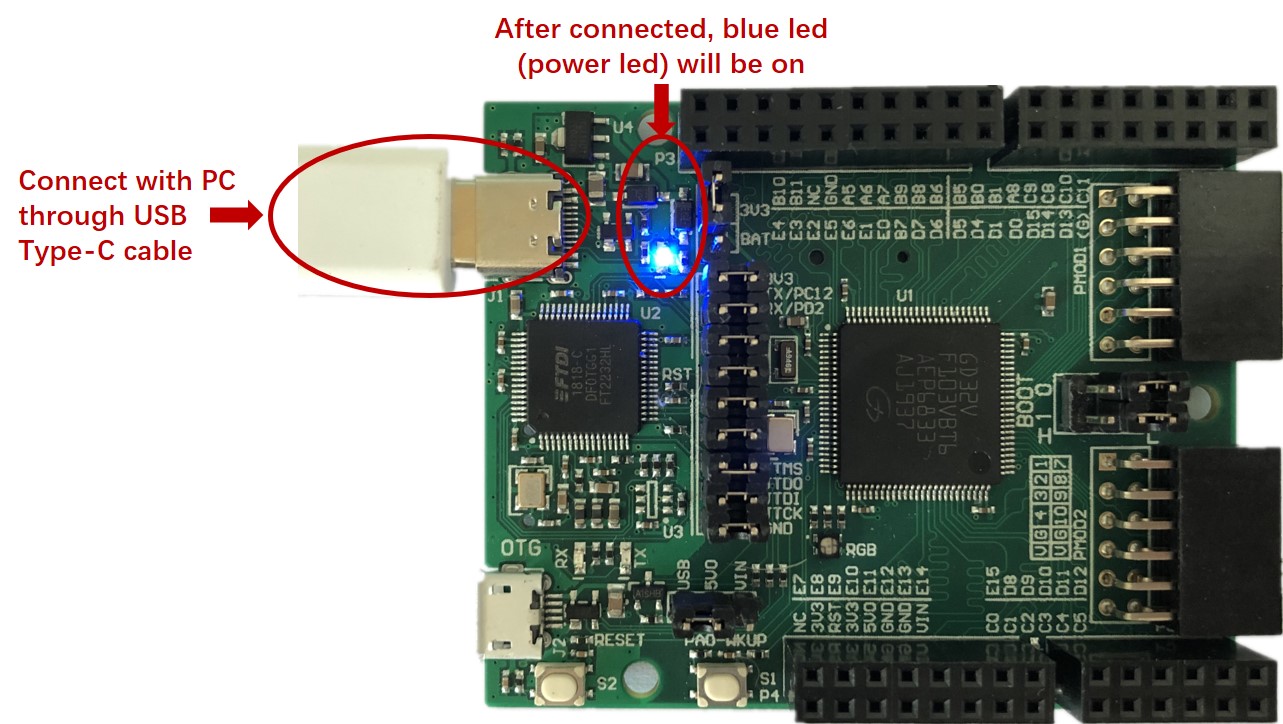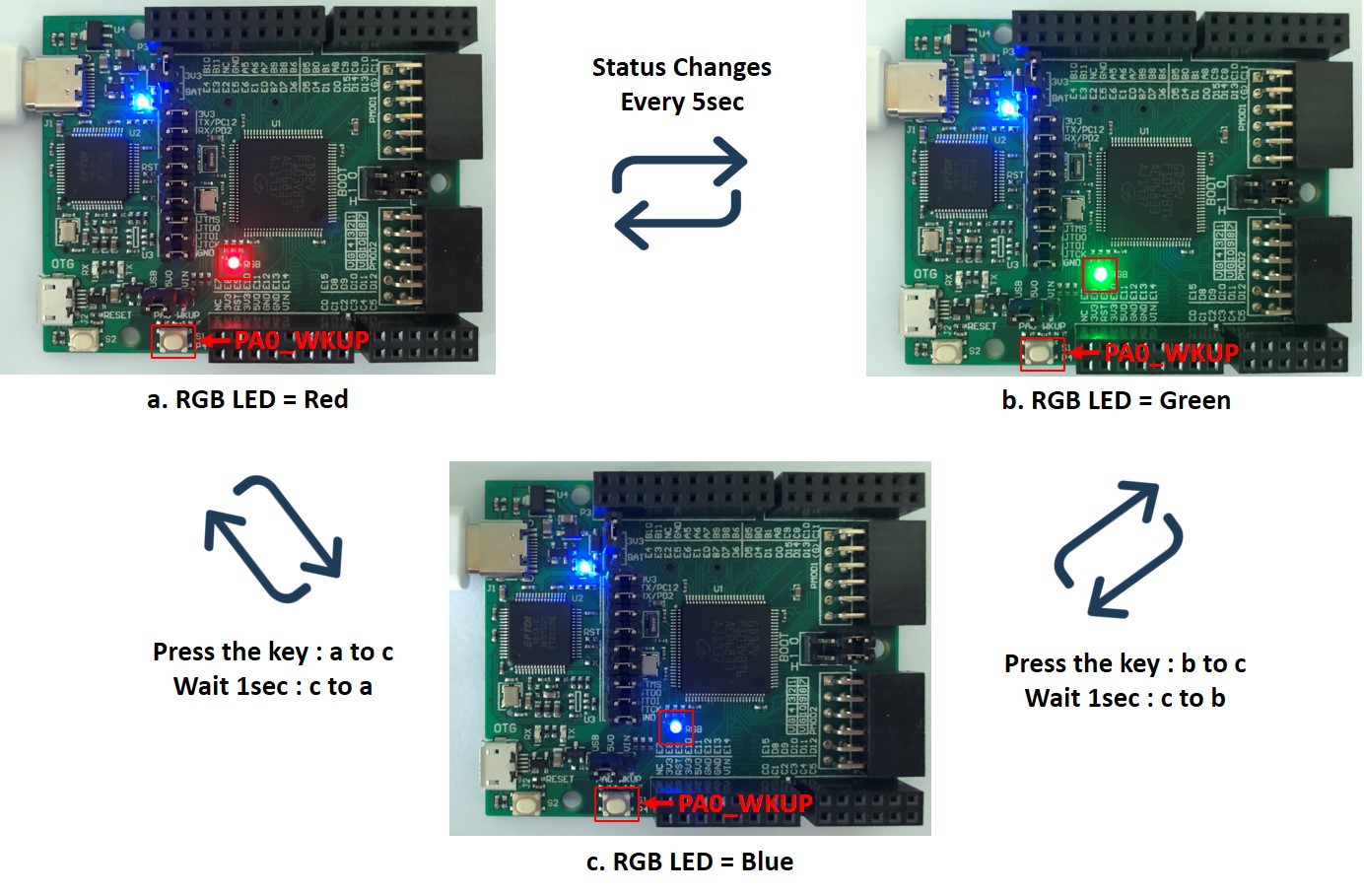4.1.1.4. Core feature: Nesting of Interrupts¶
Purpose
To get familiar with the interrupt preemption in Nuclei N Class Processors
To know how to use interrupts nesting
Requirements
The following hardware and source codes are required:
PC host
Nuclei board (RV-STAR Development Board)
USB Type-C cable
nuclei-sdk/board-labs/rvstar/nesting_of_interrupts
Content
Through learning the Chapter 6 of Nuclei RISCV ISA Spec and Interrupt and Exception Handling File in NMSIS to get familar with interrupt preemption in Nuclei N Class Processors.
Programming the EXTI peripheral registers and the Timer peripheral registers of SoC, ECLIC registers of Core to create two external interrupts which are triggered by pressing the on-board user key and SoC Timer seperately. Set both interrupts to non-vectored processing mode and set interrupt initiated by user key to a higher level. Here two interrupt service routines change on-board RGB LED to two different statuses.
Note
About the detailed setup of external interrupt, please refer to Core feature: Interrupt
Principles
While the processor is handling an interrupt, there may be another new interrupt request of a higher level, and then the core can stop the current interrupt service routine and start to taken the new one and execute its “Interrupt Service Routine”. Hence, the interrupt preemption is formed (that is, the previous interrupt has not returned yet, and the new interrupt is taken), and there could be multi-level of preemptions.
Take the following case as an example:
Assuming that the processor is operating main routine normally, suddenly an interrupt is initiated by SoC Timer. The processor will stop the execution of current main program, then turns to handle the interrupt request.
When the processor is executing SoC Timer interrupt service routine, another interrupt is initiated by user key which has a higher level than the SoC Timer interrupt. So The processor will stop processing SoC Timer interrupt service routine and start to handle the interrupt initiated by user key.
After that no other higher-level interrupts arrive, the user key interrupt will not be preempted. The processor can successfully complete the interrupt service routine of user key interrupt, and then return to process the previous interrupt service routine of SoC Timer interrupt.
Completing the SoC Timer interrupt service routine, the core will return to execute the previous main routine.

Fig. 4.16 Interrupt preemption example¶
Note
In the Nuclei processor core, the supported methods for interrupt preemption depending on whether the interrupt is a vectored interrupt or a non-vectored interrupt. Please see (CLIC mode) Vectored and Non-Vectored Processing Mode of Interrupts for more details.
In this lab, we just show how to implement nesting of non-vectored interrupt. About how to implement nesting of vectored interrupt, please refer to Core feature: Vectored Interrupt.
In Nuclei SDK, gd32vf103_rvstar.h provides API to operate the on-board peripherals, gd32vf103_timer.h provides API to operate the SoC Timer, gd32vf103_exti.h provides API to operate the SoC EXTI, core_feature_eclic.h provides API to config ECLIC feature for Nuclei Core.
The code for this lab is located in nuclei-sdk/board-labs/rvstar/nesting_of_interrupts. You can see it in the appendix.
It can be divided into 6 parts:
Part1 : Board config, initialize on-board RGB LED and user key
Part2 : Timer config, set working mode of TIMER1 and enable Timer update interrupt in SoC level
Part3 : EXTI config, set PA0 to used as EXTI source and enable EXTI interrupt in SoC level
Part4 : ECLIC config, interrupt config in Processor level for each interrupt sources (interrupt enable, level and priority, non-vectored or vectored)
Part5 : EXTI interrupt service routine, change the status of on-board RGB LED (set color to Blue)
Part6 : SoC Timer interrupt service routine, change the status of on-board RGB LED (set color to Green)
The program flow is shown below:

Fig. 4.17 Programming flow of interrupt preemption¶
Steps
Connect RV-STAR Development Board and your computer with the USB Type-C cable.

Fig. 4.18 Connect with PC¶
Note
When connect your board with the PC, just keep the on-board jumpers as default. About on-board jumpers’ function, please refer to Jumper Section.
Compile and run the
nuclei-sdk/board-labs/rvstar/nesting_of_interruptsexample. About the develop environment, you can choose Nuclei SDK or Segger Embedded Studio.
Nuclei SDK
Using the following commands:
cd /nuclei-sdk/board-labs/rvstar/nesting_of_interrupts make SOC=gd32vf103 BOARD=gd32vf103v_rvstar upload
Note
About the acquisition of source codes, please refer to Software Source Codes.
About the detailed usage of Nuclei SDK, please refer to How to develop with Nuclei SDK.
Segger Embedded Studio
Using the following actions:

Fig. 4.19 Operations in Embedded Studio¶
Note
About the acquisition of Segger Embedded Studio solutions, please refer to Software Source Codes.
About the detailed usage of Segger Embedded Studio, please refer to How to develop with Segger Embedded Studio.
Check the status of on-board RGB LED, then press the on-board User Key(PA0-WKUP), and check the status of on-board RGB LED again.

Fig. 4.20 Experimental results¶
Exercises
Try to create you own application which add more interrupt sources (such as internal interrupt source) to implement multi-level nesting of Interrupts.
Appendix
rvstar/nesting_of_interrupts/main.c
/**
\brief main function
\param[in] none
\param[out] none
\retval none
*/
int main(void)
{
uint8_t timer_intlevel=1;
uint8_t exti_intlevel =2;
int32_t returnCode;
/* Board Config */
gd_rvstar_led_init(LED3);
gd_rvstar_led_init(LED1);
gd_rvstar_led_init(LED2);
gd_rvstar_key_init(WAKEUP_KEY_GPIO_PORT,KEY_MODE_EXTI);
/* Timer Config */
soc_timer_config();
/* EXIT config */
user_key_exti_config();
/* ECLIC config */
returnCode = ECLIC_Register_IRQ(EXTI0_IRQn, ECLIC_NON_VECTOR_INTERRUPT,
ECLIC_LEVEL_TRIGGER, exti_intlevel, 0, NULL);
returnCode = ECLIC_Register_IRQ(TIMER1_IRQn, ECLIC_NON_VECTOR_INTERRUPT,
ECLIC_LEVEL_TRIGGER, timer_intlevel, 0, NULL);
/* Enable interrupts in general */
__enable_irq();
/* Timer Start */
timer_enable(TIMER1);
/* RGB Control */
while(1)
{
/* set led to RED */
gd_rvstar_led_off(LED2);
gd_rvstar_led_off(LED1);
gd_rvstar_led_on(LED3);
}
return 0;
}
/**
\brief configure the TIMER peripheral
\param[in] none
\param[out] none
\retval none
*/
void soc_timer_config()
{
timer_parameter_struct timer_initpara;
/* ----------------------------------------------------------------------------
TIMER1 Configuration:
TIMER1CLK = SystemCoreClock/54000 = 2KHz.
TIMER1CAR = 20000
---------------------------------------------------------------------------- */
rcu_periph_clock_enable(RCU_TIMER1);
timer_deinit(TIMER1);
timer_update_source_config(TIMER1, TIMER_UPDATE_SRC_REGULAR);
/* initialize TIMER init parameter struct */
timer_struct_para_init(&timer_initpara);
/* TIMER1 configuration */
timer_initpara.prescaler = 53999;
timer_initpara.alignedmode = TIMER_COUNTER_EDGE;
timer_initpara.counterdirection = TIMER_COUNTER_UP;
timer_initpara.period = 20000;
timer_initpara.clockdivision = TIMER_CKDIV_DIV1;
timer_init(TIMER1, &timer_initpara);
timer_interrupt_enable(TIMER1, TIMER_INT_UP);
}
/**
\brief configure the EXTI peripheral for user key
\param[in] none
\param[out] none
\retval none
*/
void user_key_exti_config()
{
/* enable the AF clock */
rcu_periph_clock_enable(RCU_AF);
/* connect EXTI line to key GPIO pin */
gpio_exti_source_select(WAKEUP_KEY_EXTI_PORT_SOURCE, WAKEUP_KEY_EXTI_PIN_SOURCE);
/* configure key EXTI line */
exti_init(EXTI_0, EXTI_INTERRUPT, EXTI_TRIG_FALLING);
exti_interrupt_flag_clear(EXTI_0);
}
/**
\brief EXTI line0 interrupt service routine
\param[in] none
\param[out] none
\retval none
*/
void EXTI0_IRQHandler()
{
if (SET == exti_interrupt_flag_get(WAKEUP_KEY_PIN)){
if(RESET == gd_rvstar_key_state_get(KEY_WAKEUP)){
/* clear EXTI lines interrupt flag */
exti_interrupt_flag_clear(WAKEUP_KEY_PIN);
/* set led to BLUE */
gd_rvstar_led_off(LED3);
gd_rvstar_led_off(LED1);
gd_rvstar_led_on(LED2);
delay_1ms(1000);
}
}
}
/**
\brief TIMER1 interrupt service routine
\param[in] none
\param[out] none
\retval none
*/
void TIMER1_IRQHandler()
{
uint16_t cnt;
if(SET == timer_interrupt_flag_get(TIMER1, TIMER_INT_FLAG_UP)){
/* clear update interrupt bit */
timer_interrupt_flag_clear(TIMER1, TIMER_INT_FLAG_UP);
for(cnt = 0; cnt < 5; cnt++)
{
/* set led to GREEN */
gd_rvstar_led_off(LED3);
gd_rvstar_led_off(LED2);
gd_rvstar_led_on(LED1);
delay_1ms(1000);
}
}
}